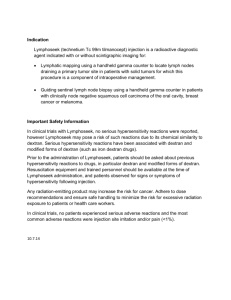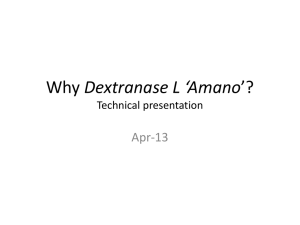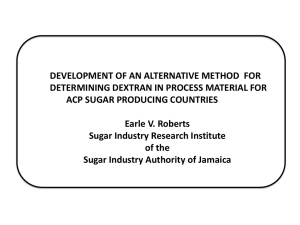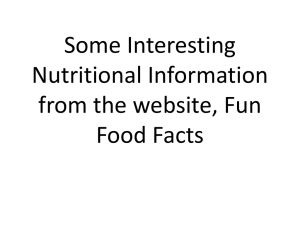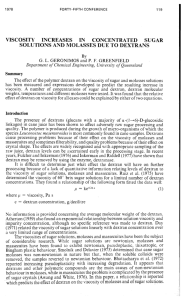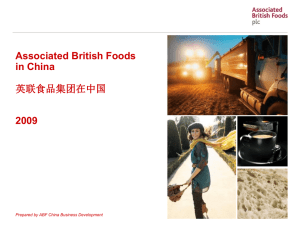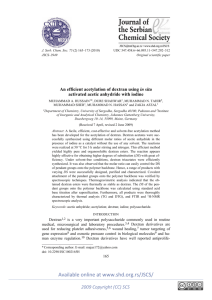3.1 - ACP-SRP
advertisement
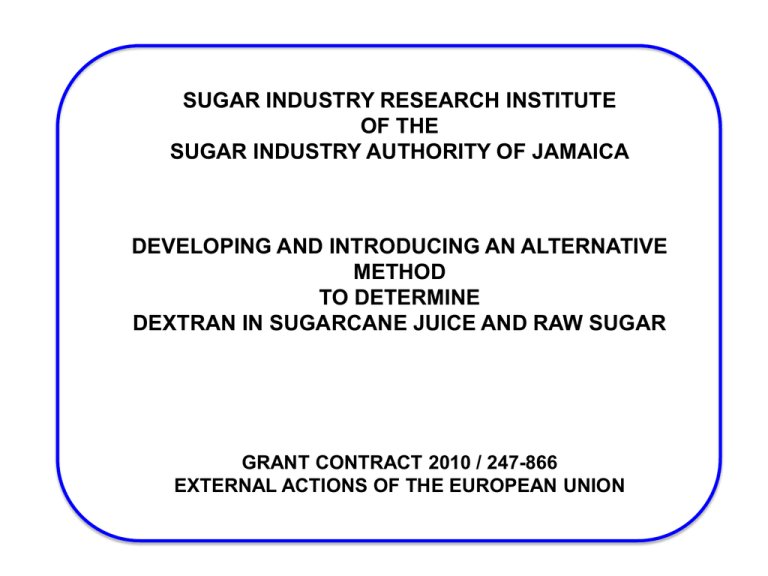
SUGAR INDUSTRY RESEARCH INSTITUTE OF THE SUGAR INDUSTRY AUTHORITY OF JAMAICA DEVELOPING AND INTRODUCING AN ALTERNATIVE METHOD TO DETERMINE DEXTRAN IN SUGARCANE JUICE AND RAW SUGAR GRANT CONTRACT 2010 / 247-866 EXTERNAL ACTIONS OF THE EUROPEAN UNION Dextran – Generic name for a group of high molecular weight polymers (Av. M ~ 5 x106 Da) Produced by the enzyme dextransucrase secreted by bacteria esp. Leuconostoc mesenteroides. Enzyme hydrolyses sucrose to fructose and glucose. Fructose is used by the organism and the remaining glucose fragment is converted to various polymers. Polymers contain α – 1,6 linkages predominantly but also elaborate various side chains linked to the main chain through α -1,2, α -1,3 or α -1,4 linkages. Dextrans from deteriorated cane or from sugars produced from deteriorated cane show high molecular weight range (M ~ 20 – 25 x 106 Da). main chain 1,6-linkage side chain 1,3-linkage Dextran fragment Whereas starch and cellulose are polysaccharides invariably present in sugarcane, the presence of dextrans is a post harvest phenomenon of sugarcane deterioration due to environmental conditions, harvesting methods, kill-to-mill delays, bacterial infection. Dextrans of differing molecular mass are reported to influence processing operations differently in conversion of sugar cane juice to sugar. Dextran slows the rate of crystallization of raw sugar, leads to the formation of irregularly shaped crystals and decreases the exhaustion of molasses, i.e. it reduces the recovery of sucrose by “dragging” sucrose (possibly equal to its weight) into the molasses mother liquor. Its presence thus results invariably in increased production costs. Dextran, because it is a polymer, increases the viscosity of sugar solutions, frequently slowing the passage of sugar solutions through the refining process to a halt; this results in significant losses of production time with corresponding increases in production costs. Thus, the presence of Dextran in cane juice is a major concern to the sugar cane industry. For example, if cane growers are paid by the miller for their canes based on the amount of sugar (sucrose) present, dextran inflates the estimation of the amount of sucrose present. If there are high levels of dextran present in the juice extracted from the cane, then: 1. The grower is paid for sugar that is not present with consequent loss in revenue to the miller. 2. Raw sugar suppliers receive lower premiums or, as is the case in U.S. markets, suffer penalties for supplying raw sugar containing dextran at levels greater than an acceptable minimum. A method of determining the level of dextran present in cane juice, process materials (syrups, molasses, raw sugar, etc.) is therefore required. This would allow processors to monitor dextran levels and, where possible, take corrective action to minimize its impact on the quality of sugar delivered to our international markets. Such a method must satisfy the following criteria: (i) (ii) (iii) (iv) It must be rapid and quantifiable. It must be accurate, reliable and reproducible. It must be able to process and analyse within a reasonable time frame the large number of samples required for representative acceptance. The equipment required should be robust and manageable by intermediate level technical staff. Several methods of dextran analysis have been published in the technical and scientific literature but they do not show all of the above characteristics. Those currently employed in the sugar industry are listed below: 1. 2. 3. 4. 5. Haze test for sugars Not specific to dextrans; repeatable but not accurate for juice samples SCGC (Belle Glade Rapid Test) Modified for juices but not specific to dextrans. Roberts Copper Test Specific to dextrans but technically difficult and time consuming (2.5 hr). Rapid Test (SPRI) Not specific to dextrans, not reproducible. Midland MCA Sucrotest Specific to dextrans; not reliable, prohibitively expensive for routine analysis. A method developed by a U.K. based firm, Optical Activity Ltd., in collaboration with the University of Westminster, London, Dextran and Sucrose Analysis (DASA), underwent preliminary field trials by the Sugar Industry Research Institute, Jamaica. Results indicated that the method had the potential to satisfy the criteria stated above but it required further refinement and evaluation. The method, based on Near Infra Red (NIR) polarimetry, evolved from experimental studies which explored the possibility of monitoring enzyme-mediated reactions (e.g. the hydrolysis of polysaccharides such as dextran by substrate-specific enzymes such as dextranase) using polarimetric techniques. Dextran is an optically active dextro-rotatory compound. Hydrolysis of dextran by acids or enzymes converts it to simpler compounds (oligo- and monosaccharides) having polarimetric properties different to those of the original dextran. Thus, changes in dextran concentration can be monitored by following the changes in the polarimetric properties of solutions containing it when these solutions are treated with dextran-specific enzymes and these changes can be measured and quantified by NIR polarimetry. Preliminary results: Studies have focussed on determining the precision and accuracy of the method at various dextran levels ranging from 100ppm – 5000ppm in sugar solutions (26%). Coefficient of variation,CV, (relative standard deviation) calculations indicate that results obtained for dextran concentrations across the range 600ppm – 5000ppm are acceptable. CV vs [Dex]/ppm 50 coefficient of variation (CV) 45 40 35 30 25 20 15 10 5 0 100 150 200 400 600 800 [Dex]/ppm 1000 1500 2000 4000 5000 Preliminary Results: Cane juice samples Cane juice samples have been collected from the main cane growing areas across the industry. Dextran values ranging from ~60ppm – 8000ppm were recorded. (Percentage accuracy of detection of dextran levels below 100ppm is low – instrument limitation) Current activities: Number of refinements to experimental procedures being explored: - Reduction in the reaction time for dextran hydrolysis (~ 15 minutes) to ~ 5 - 6 minutes to be in line with time needed for pol determination on samples. - Determining the stability and activity of the dextranase currently used. - Investigating the availability of dextranases with higher activity. Begin dextran analyses of syrup and molasses samples. Preparation of laboratory space to receive equipment on order (DASA System and HPLC Equipment ) Acknowledgements The Institute wishes to acknowledge the assistance of the European Commission and that of the ACP Sugar Research Group for the provision of financial support for the project and the ACPEU Coordinating Unit for its continuing administrative support in facilitating the project.
